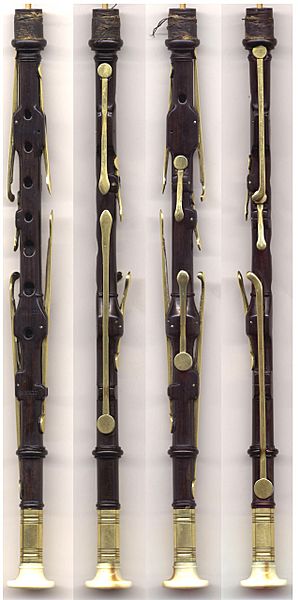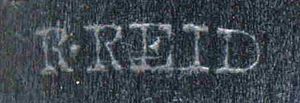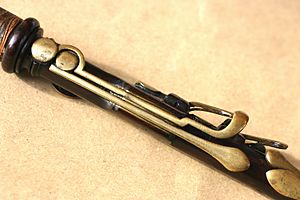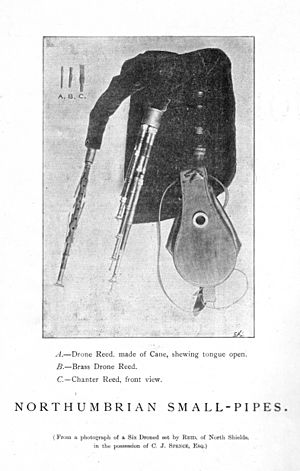Robert Reid (pipemaker) facts for kids
Robert Reid (1784 – 1837) was a very important person in the world of music. Many people believe he created the modern version of the Northumbrian Smallpipes. These are a special type of bagpipes from the North East of England.
Robert first lived and worked in Newcastle upon Tyne. Later, around 1802, he moved to North Shields. This town was a busy port near the mouth of the River Tyne.
The Reid family had a long history with pipes. Robert's father, also named Robert, was a cabinet maker. He played the "Northumbrian big-pipes." He was friends with a famous piper named James Allan. Robert Reid himself was later called "a beautiful player as well as maker" of smallpipes by James Fenwick. Robert's son, James (1814–1874), also joined the family business.
Robert Reid passed away in North Shields in January 1837. His death notice in a local newspaper called him a "piper." It also said he was a pipe maker known by everyone for the great sound and beautiful look of his instruments. He is buried in the churchyard of Christ Church, North Shields. His wife, Isabella, died in 1849 from an illness.
After Robert's death, his son James continued the business. James mainly fixed pipes, but he also made a few sets himself. He was a piper too. Robert's daughter, Elizabeth, who later became Elizabeth Oliver, was also a piper. She was the first known female Northumbrian piper!
Elizabeth and James helped the Ancient Melodies Committee. This group was collecting old tunes for a book called the Northumbrian Minstrelsy. Elizabeth later wrote to J. W. Fenwick, another music collector. She told him that the tune "Dorrington Lads" was played by her father Robert, her brother James, and herself. She was very careful about sharing the music correctly. Many tunes from the Reids, including 12 from Robert or James, are found in Fenwick's music collection.
How Robert Reid Made Pipes
Simple smallpipes had been around since the late 1600s. They became common in Northumberland during the 1700s. But keys, which help play more notes, were not added until around 1800. John Peacock's music book from that time shows a new pipe chanter with four keys. A chanter is the part of the bagpipe that plays the melody.
John Dunn, another pipe maker, worked closely with Peacock. He might have been the first to build such an instrument. However, Robert Reid's pipes from this time onward started to include keys. More keys were added to his designs over the years.
The Clough family owned a 7-key chanter made by Reid. They believed it was made for their great-grandfather around 1810 or 1820.
Reid's Seven-Key Chanter
Here is a picture of a classic seven-key chanter made by Robert Reid. It was likely made around 1820.
- From the front, you can see the fingerholes for notes like G, A, B, C, D, E, and F sharp.
- From the player's left, there are keys for low E and high A. These are played with the left little finger.
- From the back, you see the thumbhole for high G. There are also two keys for low F sharp and D sharp, played with the right thumb.
- From the right, you can see other keys for low D, C sharp, and high B. These are also played with the right thumb.
Robert Reid used a special stamp to mark the instruments he made.
Francis Wood, who is also a pipe maker, said that Reid's chanters are amazing. He noted that they seem to have appeared almost perfect from the start. Reid's designs were very practical and useful, not just fancy. The keys were built very neatly, close to the chanter. This made them less likely to get damaged. Players also found them comfortable to hold, with keys that were easy to press. These qualities are still important in well-made modern pipes today.
Later Pipe Designs
By the 1830s, Robert Reid was making chanters with 14 keys. A beautiful example of one of these, with five drones, is kept at the Morpeth Chantry Bagpipe Museum. Drones are the parts of the bagpipe that play a continuous sound. It is said that Tom Clough, a famous piper, called this set "the finest set I ever played on."
The way keys were arranged on pipes during this time has mostly stayed the same ever since.
James Reid, Robert's son, put together a complex set of pipes using parts made by his father. This set had six drones. A photo of these pipes was used on the front cover of James Fenwick's "Instruction Book for the Northumbrian Smallpipes," published in 1896. This special set was probably made for Cornelius Stanton shortly before he passed away. Only one such set is known to exist.
About 77 sets of pipes made partly or entirely by Robert Reid still exist today. Around 45 of these are owned by private collectors, and about 10 are still played. Many sets made by the Reids are also in public collections, especially at the Morpeth Chantry Bagpipe Museum.
Robert Reid also made "Union Pipes." These were an early version of what are now called Uilleann pipes.
Henry Clough (I) was known to play a set of Reid's Union pipes. Parts of this set are now owned by private collectors.






